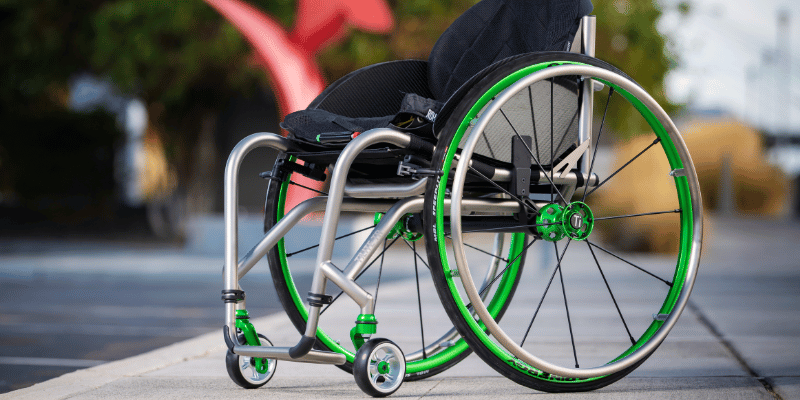The inferior foot support (AKA the footplate) position and hanger length on a wheelchair is an often overlooked but crucial part of a seating system on multiple levels. This week's blog looks at how footplate positioning can impact on posture. It is crucial that you have considered the end users ROM when determining the most appropriate positioning. In particular, we need to consider the degrees of hip flexion in relation to knee extension and any contractures at the ankle joint.
Why is foot positioning crucial?
- Having the foot appropriately supported on a footplate essentially closes the kinematic chain. This in turn assists with stability and when we have stability - function is also supported
- Supporting the foot enables us to maintain a neutral ankle position – this can assist in ongoing wearing of shoes without modification and decreased risk of pressure and odema
- Contracture development at the ankle may impede on future weight bearing capacity
- Maintains safety, decreasing risk of injury from ground surface
- Assists with pelvis positioning by supporting the lower extremities
- When foot is positioned beyond user ROM it can exacerbate PPT or postural asymmetry
Fixed vs swing away lower extremity supports
Active user ridged style frames often have a fixed foot support whereas folding frames and tilt-in-space frames often have swing away hangers. Determining which option is best for a specific user requires both postural and functional considerations. Functional considerations will include transfer style, transportation requirements and method of access (Eg foot punters require clearance to facilitate good foot strike).
Footplate position
If the user has flexibility within the ankle joint to maintain a neutral position this is the perfect starting point. When the foot is unsupported (such as when a footplate is removed) the natural position will follow gravity resulting in planter flexion which can result in contracture development over time.
Accommodating planter or dorsi flexion of the ankle joint can be achieved through being able to adjust the angle of the footplate. Most configurable chairs have this option. Some footplates can also be adjusted to assist with accommodation of inversion and eversion. Different manufacturers will have slightly different ways in which this can be achieved. The mechanism adjustment style may enable either incremental or infinite adjustment within the range possible.
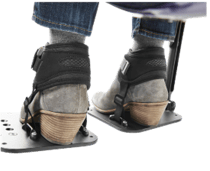 Customisation may also be a consideration such as individualised wedges on the footplate. Supporting the foot when there is limited reducibility of deviation, can reduce the risk of further postural deformity. Additional supports on the footplate may need to be considered to assist in maintaining appropriate alignment. Think about the points of control and opposite and equal forces and how this can be achieved.
Customisation may also be a consideration such as individualised wedges on the footplate. Supporting the foot when there is limited reducibility of deviation, can reduce the risk of further postural deformity. Additional supports on the footplate may need to be considered to assist in maintaining appropriate alignment. Think about the points of control and opposite and equal forces and how this can be achieved.
Hanger Angle
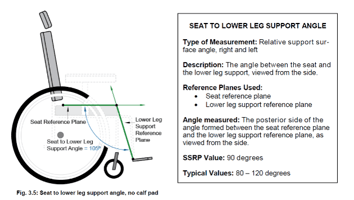
The hanger or lower leg support may be part of the frame or attached to the frame. The foot support is attached to this.
Image: From “A CLINICAL APPLICATION GUIDE TO STANDARDIZED WHEELCHAIR SEATING MEASURES OF THE BODY AND SEATING SUPPORT SURFACES” Kelly Waugh
 The hanger angle needs to be determined based on the ROM of knee extension with the hip flexed and ultimately guided by final position required for the foot support. Limitations to knee extension will require a foot position closer to the frame so may need a more closed or tighter hanger angle. Caster clearance needs to be considered in these cases as when the castor turns, it can sometimes be impeded by fowling with the footplate. Some footplates may allow for you to mount the footplate further back so you may still be able to configure a 90 degrees flexed knee on an 80 degree hanger. You still will need to consider the castor foot support relationship to ensure both posture and function of the base are optimal.
The hanger angle needs to be determined based on the ROM of knee extension with the hip flexed and ultimately guided by final position required for the foot support. Limitations to knee extension will require a foot position closer to the frame so may need a more closed or tighter hanger angle. Caster clearance needs to be considered in these cases as when the castor turns, it can sometimes be impeded by fowling with the footplate. Some footplates may allow for you to mount the footplate further back so you may still be able to configure a 90 degrees flexed knee on an 80 degree hanger. You still will need to consider the castor foot support relationship to ensure both posture and function of the base are optimal.
Hanger length
When lower limb length growth occurs and the hanger length is not adjusted to accommodate, it's not uncommon to see decreased femoral loading and increased abduction. Children need to be regularly reviewed and adjustments made to ensure optimal positioning is maintained.
The following is a case example from a user I was asked to review a few years ago. A referral came through regarding a user not sitting well in seating, the left leg was abducted and externally rotated and leaning heavily on hanger leaving indentations. There was a big gap between the users back and the back support and the left foot was coming off the front of the footplate. The request stated that the left footplate had been adjusted as far forwards as possible and that the foot was still coming off the front so they wanted to know what further adjustment was possible and a review of seating. At the appointment it was identified that there was a limitation in hamstring ROM. The therapist was new to the client and had not been a part of the initial assessment but had taken on the case for delivery. Based on the referral information it was decided that a review of lower extremity ROM needed to be done to identify if the users range and the configuration of equipment was exacerbating the postural tendency, just moving the footplate further out without knowing the ROM was just band-aiding the symptoms, for ongoing best outcome we needed to identify the causation.
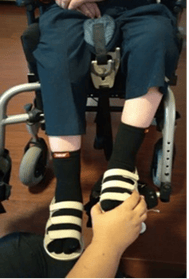 Picture 1 shows the left foot positioned on the footplate. There is limited femoral loading on the left and can also see the external rotation and abduction from the left hip joint.
Picture 1 shows the left foot positioned on the footplate. There is limited femoral loading on the left and can also see the external rotation and abduction from the left hip joint.
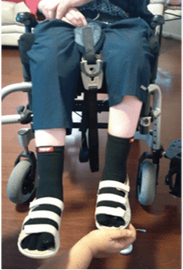
Image 2 the footplate is swung away, and the foot is being held in the optimal position – notice how the external rotation and abduction are significantly reduced as the footplate height was exacerbating the postural positioning. Also note that the knee angle is different with each limb, the left foot due to the ROM limitations needs to be positioned further back.
The reason for the foot coming off the front of the footplate correlates with the postural position being pulled forwards due to the limitation in knee and hip ROM, the backrest required no changes and the gap behind the user was eliminated by appropriate foot positioning.
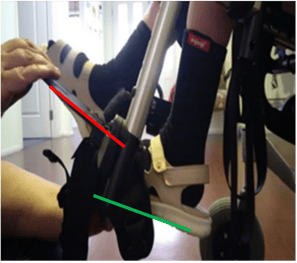
Picture 3 shows the left foot in required position and the left footplate in existing position. The lines have been added to highlight the difference in both height and angle. (The red line shows where the left footplate was positioned vs the green line which was determined as optimal position based on ROM.
It’s OK to have the feet positioned unevenly, the importance is to position within the measured ROM and each foot has to be appropriately supported. It's essential that the users and their supports understand the difference is intentional and why it will result in better outcomes.
Author

Tracee-Lee Maginnity BHSc (OT)
Clinical Services Specialist
Tracee-Lee Maginnity joined Permobil Australia in July 2019, as a clinical education specialist. Originally from New Zealand, she graduated Auckland University of Technology with a BHSc (Occupational Therapy) in 2003 and has since worked in various roles related to seating and mobility including assessing, prescribing and educating. After gaining experience as an assessor and prescriber at Seating To Go / Wheelchair Solutions in prescribing for both disability and injury, she moved to Australia in 2011 to take on the Senior Occupational Therapist role in a custom moulded seating service. She then worked in clinical consulting and education roles until joining Permobil. Tracee-Lee is passionate about maximising functional outcomes with end users and the importance of education within the industry. She has mentored many therapists interested in AT. Her experience includes working with complex postures to achieve custom outcomes. Tracee-Lee is also an international wheelchair rugby classifier where she enjoys the task analysis of wheelchair propulsion and functional capacity identification of athletes.
